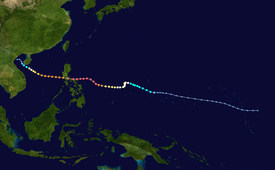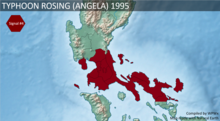Typhoon Angela
 Angela at peak intensity nearing the Philippines on November 1 | |
| Meteorological history | |
|---|---|
| Formed | October 25, 1995 |
| Dissipated | November 7, 1995 |
| Violent typhoon | |
| 10-minute sustained (JMA) | |
| Highest winds | 215 km/h (130 mph) |
| Lowest pressure | 910 hPa (mbar); 26.87 inHg |
| Category 5-equivalent super typhoon | |
| 1-minute sustained (SSHWS/JTWC) | |
| Highest winds | 285 km/h (180 mph) |
| Lowest pressure | 879 hPa (mbar); 25.96 inHg |
| Overall effects | |
| Fatalities | 936 total |
| Damage | $315 million |
| Areas affected | |
| IBTrACS | |
Part of the 1995 Pacific typhoon season | |
Typhoon Angela, known in the Philippines as Super Typhoon Rosing, was an extremely powerful and catastrophic tropical cyclone that impacted the Philippines in November 1995, and the most intense tropical cyclone worldwide in 1995. Typhoon Angela was the third storm in a row that struck the Philippines, following Yvette and Zack. Typhoon Angela was the twenty-ninth tropical cyclone, and the fifth super typhoon of the moderately active 1995 Pacific typhoon season.
Angela caused PHP 9.33 billion worth of damage across the Philippines, in addition to 882 fatalities. It was the strongest typhoon to hit the Philippines since Typhoon Joan in 1970, and the costliest since Typhoon Mike in 1990.
Meteorological history
[edit]
Tropical storm (39–73 mph, 63–118 km/h)
Category 1 (74–95 mph, 119–153 km/h)
Category 2 (96–110 mph, 154–177 km/h)
Category 3 (111–129 mph, 178–208 km/h)
Category 4 (130–156 mph, 209–251 km/h)
Category 5 (≥157 mph, ≥252 km/h)
Unknown
The monsoon trough that developed Yvette and Zack spawned another tropical depression on October 25 in conjunction with a tropical disturbance that originated in the Marshall Islands. It moved to the west, organizing very slowly, becoming a tropical storm on October 26.[1] Two days later, Angela further intensified into a typhoon, and between October 31 and November 1, Angela rapidly intensified into a Category 5-equivalent super typhoon with 1-minute sustained winds of 285 km/h (180 mph), while the Japan Meteorological Agency reported peak 10-minute sustained winds of 215 km/h (130 mph). It maintained that intensity before gradually weakening as it tracked westward, making landfall in the Philippines on November 2 with 1-minute sustained winds of 260 km/h (160 mph) –still at Category 5-equivalent intensity.[2] Angela continued to the west-northwest, where upper-level winds caused it to dissipate on November 7 over the Gulf of Tonkin.[3]
Impact, records, and retirement
[edit]
More than 900 people died due to the typhoon. It wreaked havoc over Metro Manila, Calabarzon and Bicol Region. It caused a total of 10.829 billion pesos in damage.[4]

More than 96,000 houses were destroyed throughout the affected area, along with bridges and roads. The worst impact was in the Bicol Region. Angela passed almost right over Manila, causing a significant impact both there and in Catanduanes. In Calauag, storm surges and flooding from a dam failure killed 121 people. In nearby Paracale, mudslides killed more than a hundred people. Power outages affected one-third of the country.[5]
Although the JMA, which is the official regional specialized meteorological center of the western Pacific, estimated a minimum central pressure of 910 mbar (26.87 inHg), the JTWC unofficially estimated a central pressure of 879 mbar (25.96 inHg), which would rank it high on the list of most intense tropical cyclones, but still behind Typhoon Tip,[6] the most intense tropical cyclone ever recorded.[7] However, Angela is an unofficial contender for world's most intense tropical cyclone. In a study utilizing the Dvorak technique for analysis of post-1987 typhoons, the authors concluded that Angela and 1992's Gay were higher on the scale than Tip. The authors also thought that Angela might have been slightly more intense than Gay, and hence Tip.[8]
Angela was the strongest typhoon to hit the Philippines since 1970's Joan.[1] A weather observatory in Catanduanes reported a gust of 259 km/h (161 mph). This makes it the typhoon with third-highest gust recorded in the Philippines.[9]
Due to the high death toll and catastrophic damages, PAGASA officially retired the name Rosing from the rotating naming lists. It was replaced by Rening, which was used once in the 1999 season.
See also
[edit]- Typhoons in the Philippines
- Typhoon Mike (Ruping, 1990)
- Typhoon Xangsane (Milenyo, 2006)
- Typhoon Nesat (Pedring, 2011)
- Typhoon Bopha (Pablo, 2012)
- Typhoon Haiyan (Yolanda, 2013)
- Typhoon Megi (Juan, 2010)
- Typhoon Rai (Odette, 2021)
- Typhoon Rammasun (Glenda, 2014)
- Typhoon Tembin (Vinta, 2017)
- Typhoon Ketsana (Ondoy, 2009)
- Typhoon Nock-ten (Nina, 2016)
- Typhoon Doksuri (Egay, 2023)
- Typhoon Mangkhut (Ompong, 2018)
- Typhoon Kammuri (Tisoy, 2019)
- Typhoon Man-yi (Pepito, 2024)
- Typhoon Goni (Rolly, 2020) – had a similar track and landfall date (late October to early November) in 2020.
- Typhoon Noru (Karding, 2022) – also took a similar track.
References
[edit]- ^ a b "Super Typhoon Angela (29W)" (PDF). 1995 Annual Tropical Cyclone Report. Joint Typhoon Warning Center. p. 170. Archived from the original (PDF) on 2011-06-07. Retrieved 2008-11-02.
- ^ "Super Typhoon Angela (29W)" (PDF). 1995 Annual Tropical Cyclone Report. Joint Typhoon Warning Center. p. 171. Archived from the original (PDF) on 2011-06-07. Retrieved 2008-11-02.
- ^ "Super Typhoon Angela (29W)" (PDF). 1995 Annual Tropical Cyclone Report. Joint Typhoon Warning Center. p. 173. Archived from the original (PDF) on 2011-06-07. Retrieved 2008-11-02.
- ^ David Michael Padua & Dominic Alojado (2008-06-10). "11 Worst Typhoons in the Philippines". Typhoon2000.com. Archived from the original on 2008-10-16. Retrieved 2007-02-04.
- ^ "Super Typhoon Angela (29W)" (PDF). 1995 Annual Tropical Cyclone Report. Joint Typhoon Warning Center. p. 175. Archived from the original (PDF) on 2011-06-07. Retrieved 2008-11-02.
- ^ Dunnavan. "Typhoon Tip (23)" (PDF). 1979 Annual Typhoon Report. Joint Typhoon Warning Center. p. 73. Archived from the original (PDF) on 2011-06-07. Retrieved 2008-10-31.
- ^ Chris Landsea (2006-11-28). "Subject:E1) Which is the most intense tropical cyclone on record?". FAQ: Hurricanes, Typhoons, and Tropical Cyclones. Atlantic Oceanographic and Meteorological Laboratory Hurricane Research Division. Retrieved 2008-10-31.
- ^ Karl Hoarau; Gary Padgett & Jean-Paul Hoarau. "Have There Been Any Typhoons Stronger Than Super Typhoon Tip?" (PDF). American Meteorological Society.
- ^ David Michael Padua & Dominic Alojado (2008-06-11). "Strongest Typhoons of the Philippines (1947 - 2006)". Typhoon2000.com. Archived from the original on 2008-09-28. Retrieved 2008-10-31.
External links
[edit]- JMA General Information of Typhoon Angela (9520) from Digital Typhoon
- JMA Best Track Data (Graphics) of Typhoon Angela (9520)
- JMA Best Track Data (Text)
- JTWC Best Track Data Archived 2013-10-04 at the Wayback Machine of Super Typhoon 29W (Angela)

